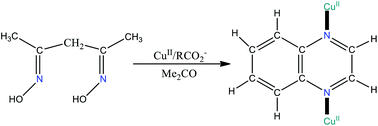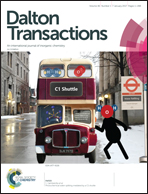A unique copper(ii)-assisted transformation of acetylacetone dioxime in acetone that leads to one-dimensional, quinoxaline-bridged coordination polymers†‡
Abstract
The reactions of copper(II) carboxylate sources with acetylacetone dioxime (acacdoH2) in Me2CO have been studied and a novel, metal ion-assisted ligand transformation has been discovered. The reaction of [Cu2(diba)4(dibaH)2] and acacdoH2 (1 : 1.5) in Me2CO has provided access to the complex {[Cu2(diba)4(qunx)]}n (1) in low yield (25–30%), where dibaH is 3,3-dimethylbutyric acid and qunx is quinoxaline. The [Cu2(piv)4(pivH)2]/acacdoH2 (1 : 1.5) reaction system in warm Me2CO, where pivH is pivalic acid, gave the analogous complex {[Cu2(piv)4(qunx)]}n (2) in moderate yield (∼50%). Complexes 1 and 2 can be easily prepared by the direct 1 : 1 reactions between the corresponding copper(II) carboxylate starting materials and qunx in Me2CO and MeOH, respectively. The formation of coordinated qunx in 1 and 2 is CuII-promoted (assisted) as suggested by the failure to synthesize the free qunx by a variety of reactions of acacdoH2 and Me2CO under aerobic conditions in the absence or even the presence of dibaH and pivH, respectively. The observed acacdoH2 → qunx transformation is catalytic and new in the chemistry of the dioximes of β-diketones, and a mechanism has been proposed based on well-established reactions of organic chemistry. The mechanism is based on a double Beckmann rearrangement-type transformation and the overall scheme is represented by the 1 : 1 : 1 reaction between acacdoH2, Me2CO and O2. Complexes 1 and 2 have similar molecular structures consisting of paddle-wheel {Cu2(η1:η1:μ-O2CR)4} units bridged by qunx ligands in a zigzag 1D chain arrangement. The geometry of the CuII ions is square pyramidal with a quinoxaline nitrogen atom occupying the apical position at each metal ion. Weak H bonds are present within the chains, the donors being qunx carbon atoms and the acceptors being coordinated carboxylate oxygen atoms. Neighbouring chains interact through C–H⋯π interactions between diba−/piv− methyl groups and the “pyrazine” part of qunx forming layers which are stacked along the b (1) or a (2) axis through weak van der Waals interactions. The packing of the layers is different in the two structures, due to the different nature of the carboxylate ligands. Hirshfeld surface analysis of the two structures reveals the similarity of the interchain (intralayer) interactions. The IR and Raman data of 1 and 2 are discussed in terms of the coordination mode of the carboxylate groups and permit assignments of some characteristic bands/peaks of coordinated qunx. Dc magnetic susceptibility studies in the 1.8–310 K range reveal very strong antiferromagnetic CuII⋯CuII exchange interactions within the carboxylate-bridged Cu2 units (J = −479 K for 1 and −532 K for 2 using the H = − J∑S1·S2 spin Hamiltonian) and weaker antiferromagnetic interactions between the Cu2 units via the qunx superexchange pathways, with the latter being ∼10% in strength compared to the former. A critical discussion of the acacdoH2 → qunx transformation in 1 and 2 is provided in the light of other impressive, recently discovered CuII-assisted transformations of acacdoH2, pointing out the key role of the solvent in the processes known to date.


 Please wait while we load your content...
Please wait while we load your content...